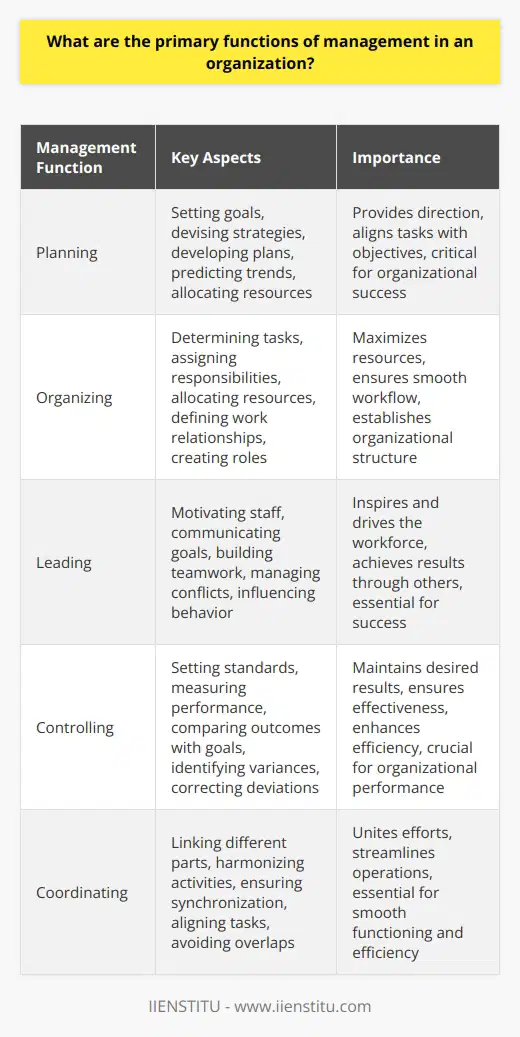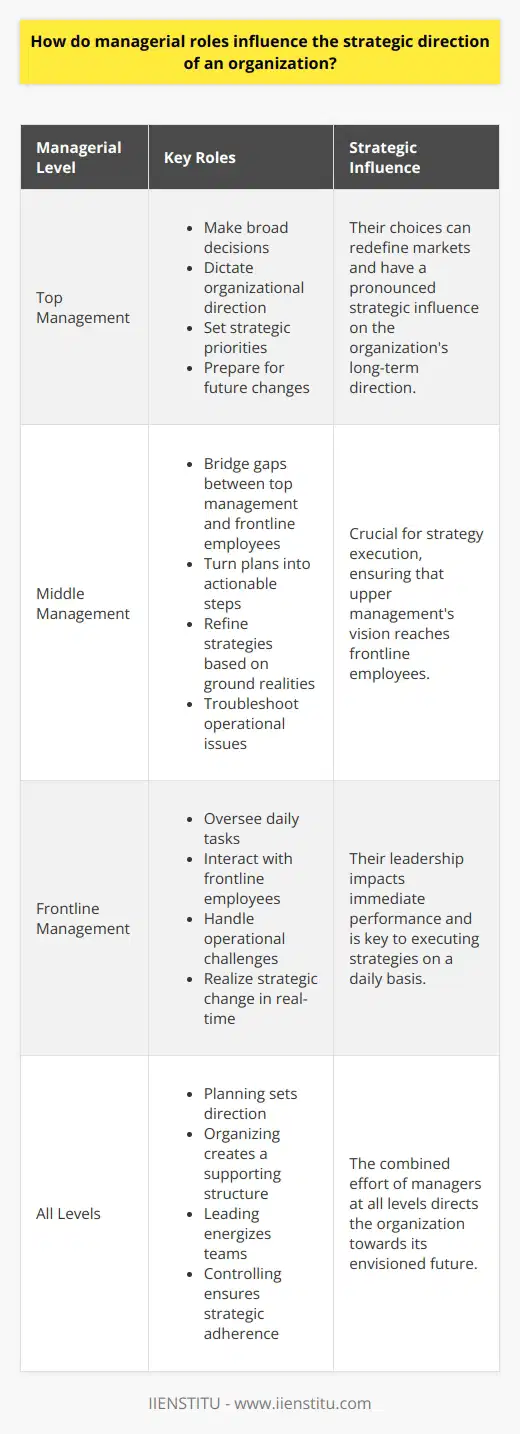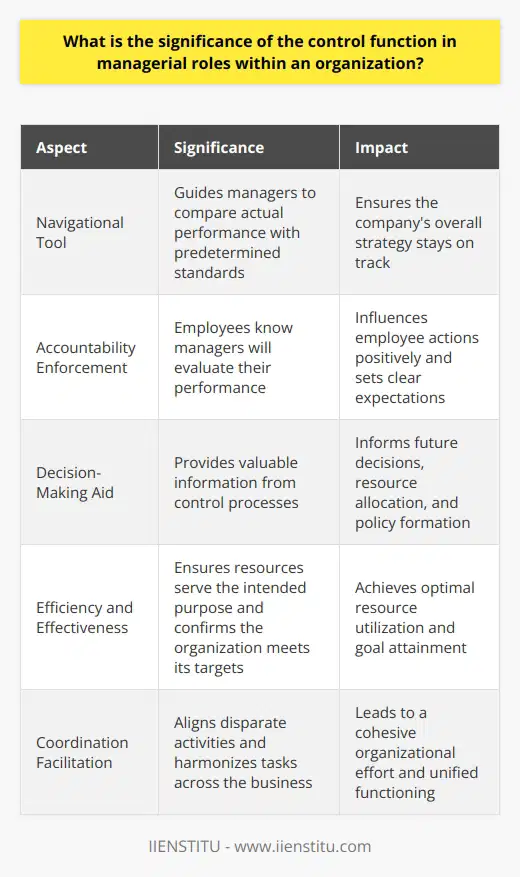
In the dynamic sphere of business where leadership molds the framework for success and sustainability, the significance of managerial roles cannot be overstated. These roles, intricate in design, function not only as the steering wheel directing the organization's journey but also as the engine propelling it towards its objectives.
This blog aims to dissect the key elements and core functions of management—the lifeblood of organizational excellence. By scrutinizing these managerial functions, we will decipher the pivotal responsibilities inherent to organizational administration and the substantial impact wielded by effective management practices.
The intention, therefore, is to furnish a granular understanding of the key roles of managers as well as the weighty responsibilities of management that orchestrate the symphony of corporate operations.
Defining Managerial Roles in Business
Clarification of the Term 'Managerial Roles'
Managerial roles in business encapsulate a spectrum of activities and responsibilities that are fundamental to the functioning of any enterprise. These roles are characterized by a set of behaviors and skills that facilitate the achievement of organizational goals. Managerial roles are tailored according to the hierarchical situation of the manager and the specific needs of the business. What remains constant, however, is the unconditional necessity for leaders to adapt, envision, and guide their teams systematically and strategically.
The Evolution of Managerial Functions Over Time
The narrative of managerial functions is one of evolution and adaptation. In the early 20th century, the work of theorists like Henri Fayol mapped out the basic principles of managerial work which have since been expanded upon and reimagined. The digital age has necessitated swift adaptations to these roles, particularly given the increased pace of change and globalized connectivity of markets.
The Interrelationship Between Managerial Roles and Organizational Success
The symbiosis between managerial roles and organizational success is clear and potent. Effective managerial practices catalyze higher productivity, innovation, and morale, while poor management can lead to inefficiencies, low employee satisfaction, and ultimately, commercial failure. In essence, the health and performance of an organization are direct reflections of its managerial ideologies and practices.
Core Functions of Management
Planning
Explanation of Strategic Versus Tactical Planning
Strategic planning involves setting long-term objectives and determining actions for achieving the broader organizational vision. In contrast, tactical planning is about implementing smaller, actionable steps that operationalize the strategic plan on a short-term basis. Both levels of planning require thorough analysis and a clear understanding of the organization's strengths, weaknesses, opportunities, and threats (SWOT).
The Role of Forecasting and Setting Objectives
Forecasting is indispensable in planning as it guides managers to anticipate future trends and challenges. Setting clear, measurable, and achievable objectives is a critical step that aligns the entire organization towards a common goal. It aids in resource allocation and prioritizes initiatives to ensure effectiveness and efficiency.
Illustration with Examples of Effective Planning
Successful companies like Tesla and Samsung are testament to the power of effective planning. Tesla's strategic focus on sustainable energy and long-term investment in research and development has established the company as a leader in the automobile industry. Samsung's tactical responsiveness to market demands and swift innovation cycles have contributed to its dominance in the electronics market.
Organizing
Defining Organizational Structures and Design
Organizing is the process of establishing internal company structure and allocating resources to ensure the execution of plans. This includes defining roles and responsibilities, creating the organizational chart, and developing the frameworks within which teams operate. A well-organized structure facilitates communication and operational efficiency.
Delegating Authority and Establishing Work Flow
Effective management involves delegating authority and establishing clear work flows. This involves empowering team members through trust and accountability, which in turn enhances morale and productivity. The delegation of authority ensures that decision-making is as close as possible to the action.
Use of Case Studies of Organizational Effectiveness
Exemplary organizations such as Google have showcased the power of flat organizational structures in fostering innovation and agility. On the other hand, companies like IBM have demonstrated how traditional hierarchical structures can be efficient in stable industries when combined with strong leadership and clear communication channels.
Leading
Outlining Leadership vs. Management
Leadership and management, though intertwined, differ in their core essence. Leadership is about inspiring and motivating people to achieve a vision, while management concerns itself with the administrative and procedural aspects of achieving strategic goals. An effective manager must be both a visionary leader and a capable administrator.
Characteristics of Effective Leadership
Effective leaders demonstrate attributes such as emotional intelligence, decisiveness, accountability, and the ability to communicate a clear vision. These characteristics not only inspire trust and respect among team members but also drive cohesion and goal alignment across the organization.
Real-world Instances Demonstrating Leadership Impact
Leaders such as Satya Nadella at Microsoft have transformed the company culture and financial performance through empathetic leadership and a focus on innovation. Indra Nooyi's tenure at PepsiCo is another example where strategic leadership led to a significant reorientation of the company's product lineup towards healthier options, driving growth and industry leadership.
Controlling
The Concept of Performance Measurement
Controlling involves the establishment of performance standards, monitoring actual performance, and taking corrective actions. This is achieved through performance measurements that provide quantitative and qualitative data on how well the organization is progressing towards its objectives.
Implementing Control Systems and Processes
The implementation of control systems involves processes such as audits, reviews, and performance appraisals. These systems help managers identify deviations from the plan and initiate timely adjustments. Effective control ensures that organizational activities remain aligned with strategic objectives.
Presentation of Scenarios Showcasing Positive Control Outcomes
An excellent example of effective control systems is seen in the ISO quality management standards adopted across various industries. Companies that adhere to ISO standards can achieve higher levels of quality control, thereby enhancing customer satisfaction and operational performance.
Additional Key Roles of Managers
Decision Making
The Process and Significance of Managerial Decision-making
Decision making is at the heart of managerial roles and represents the bridge between planning and action. It involves evaluating different options, considering potential risks and rewards, and choosing the most viable course of action. Sound decisions propel an organization forward, while poor ones can lead to detrimental outcomes.
Balancing Risk and Reward in Choices
Effective managers are adept at evaluating the trade-offs between risk and reward in their decisions. They apply analytical and intuitive approaches to balance the potential for innovation with the need for stability, ensuring sustainable growth and competitive advantage in the long run.
Examples of Critical Decision Points and Outcomes
Historical business decisions, such as Apple's move to design its own chips or Netflix's transition from DVD rentals to streaming, demonstrate the profound impact decision making has on the trajectory of a company. These decisions, inherently risky at the time they were made, have defined the competitive landscapes of their respective industries.
Communication
The Role of Communication in Management
Communication is the connective tissue of an organization. Clear, transparent, and effective communication bridges the gap between strategy and implementation, allowing for the seamless transmission of ideas and instructions from managers to their teams.
Addressing Barriers and Fostering Clear Communication
Managers must recognize barriers to communication such as cultural differences, technological challenges, and personal biases. By fostering an environment of open dialogue and using a variety of communication channels, managers can ensure that the message is conveyed accurately and is receptive to feedback.
Case Studies Highlighting Effective Communication
Companies renowned for their corporate communication, such as Southwest Airlines, have shown that investing in communication training and creating a culture of openness can lead to enhanced employee engagement and improved customer service.
Responsibilities of Management in Modern Organizations
Addressing Ethical Considerations and Corporate Social Responsibility
Modern managers must navigate the myriad of ethical considerations that define the contemporary business landscape. They are responsible for upholding ethical standards and integrating corporate social responsibility (CSR) into their business models, fostering trust with stakeholders and contributing beneficially to society.
Embracing Diversity and Inclusion Within Organizational Administration
As the world becomes more interconnected, a diverse and inclusive workforce becomes increasingly essential. Managers must ensure that their organizational practices are fair, equitable, and inclusive, recognizing the value that a diverse array of perspectives contributes to innovation and productivity.
Implementing Change and Innovation Management
The ever-accelerating pace of change necessitates that managers be skilled in change and innovation management. They must create a culture that embraces change, encourages innovation, and responds dynamically to external pressures and opportunities.
Challenges and Future Trends in Managerial Roles
Adapting to Technological Advancements and Digital Transformation
Today's managers are tasked with steering their organizations through the complex waters of digital transformation. This involves integrating new technologies and adapting to the changing digital landscape while ensuring the organization's core values and objectives remain steadfast.
Cross-cultural Management in a Globalized Business Environment
The globalization of business has made cross-cultural management a critical skill for managers. They must be agile in navigating diverse cultures, languages, and business practices to ensure the effective functioning of their global teams and international operations.
Preparing for Sustainability and the Green Business Movement
Sustainability is a growing concern, and managers must lead the way in making their organizations eco-friendly. This involves going beyond compliance and proactively seeking ways to improve environmental performance, demonstrating leadership in the burgeoning green business movement.
The indispensable nature of managerial functions in shaping the modern organizational framework has been unmistakably outlined through our exploration.
As the guardians of efficiency and innovation, managers uphold a vast array of strategic and operational responsibilities, their actions deeply imprinted on the corporate ethos and financial bottom line. As the landscape of management continues to evolve, proactive and continuous learning emerges as a non-negotiable requisite for future managerial success. It is through this proactive engagement that we can ensure the vitality and adaptability of management functions in the face of an ever-changing business environment.
Suggested Books and Articles for Deepening Understanding
To further enhance one's expertise and competence in managerial roles, a wealth of resources is available. Books such as "Management: Tasks, Responsibilities, Practices" by Peter F. Drucker and "Good to Great: Why Some Companies Make the Leap...And Others Don't" by Jim Collins provide deep insights into effective managerial practices.
Professional Organizations and Courses for Ongoing Learning
For continued professional development, engagement with professional organizations and enrolling in MBA online courses or other online courses with certificates can prove invaluable. The resources acquired through such educational endeavors equip managers with the latest knowledge and industry practices, ensuring they remain at the forefront of management thought and ability.
Engaging with Thought Leaders and Industry Experts
Lastly, connecting with thought leaders and industry experts via conferences, webinars, and social networks can offer reflection on one’s own managerial approaches and philosophies. The perspective gained from a community of professionals nurtures the innovation and critical thinking necessary for driving organizational brilliance and managerial excellence.
Frequently Asked Questions
What are the primary functions of management in an organization?
Management Functions in an Organization
Planning
Organizations begin with planning. This defines future actions. Managers set goals. They devise strategies. They develop plans to coordinate activities. Planners also predict future trends. Planning involves resource allocations. It aligns tasks with objectives. Planning is critical. It gives direction.
Organizing
After planning, managers organize. They determine what tasks to do. Managers also assign those tasks. They allocate resources effectively. Organizational structure is key. It defines work relationships. Managers also create roles. Organizing maximizes resources. It ensures smooth workflow.
Leading
Successful management involves leading. Leaders motivate staff. They communicate goals. Leaders also build teamwork. They manage conflicts. Leadership drives the workforce. It influences behavior. Good leadership inspires. It achieves results through others.
Controlling
Controlling ensures plans work. Managers set standards. They measure performance. Managers compare outcomes with goals. This identifies variances. They correct deviations. Control maintains desired results. It ensures effectiveness. It enhances efficiency.
Coordinating
Coordinating is essential. It links different parts. Managers harmonize activities. They ensure synchronization. Coordination aligns tasks. It avoids overlaps. Coordinating unites efforts. It streamlines operations.
Communicating
Communication underpins functions. Managers share information. They provide feedback. Communication connects team members. It helps decision making. Effective communication is vital. It ensures clarity. It prevents misunderstandings.
Decision-making
Decision-making drives actions. Managers assess situations. They choose among alternatives. Good decisions use data. Managers also consider implications. Decision-making is continual. It supports other functions. It addresses issues promptly.
Motivating
Motivation energizes staff. Managers create incentives. They foster a positive culture. Motivation boosts performance. It encourages goal achievement. It retains talent. It increases productivity.
Each function is crucial. Managers must excel in all. These functions are interrelated. They ensure organizational success. Managers who master these create efficient, effective environments. They lead successful teams. They achieve organizational goals. They adapt to changes. Constant improvement is key. Management functions evolve with time. Organizations depend on robust management. It drives growth. It solves problems. It maximizes potential. Managers shape the future. They turn plans into reality. They make organizations thrive.

How do managerial roles influence the strategic direction of an organization?
Managerial Roles Shape Strategic Direction
Managers form the backbone of any organization. They create, communicate, and implement strategies. Their roles range through planning, organizing, leading, and controlling. Each role carries weight in strategic direction.
Planning and Strategic Vision
Managers begin with planning. They set objectives. Goals align with the company's vision. This stage defines strategic direction from the outset. It influences resource allocation. Short and long-term plans emerge. They reflect managers' perceptions of market conditions.
Organizing and Structural Design
After planning, managers organize. They define work roles. They establish departments. This organizational structure dictates information flow. It supports or hinders strategic initiatives. Managers decide how teams collaborate. These decisions shape how strategy unfolds.
Leading and Strategic Influence
Leadership is pivotal. Managers motivate and guide employees. They set the tone for the workplace. Their leadership style impacts company culture. Positive cultures foster innovation. Innovation drives strategic success. Managers communicate the strategy. They make it resonate with the team. This ensures everyone works towards common goals.
Controlling and Strategic Adjustment
Controlling involves monitoring performance. Managers use metrics and feedback. They gauge progress towards objectives. Adjustments occur when necessary. Swift rectifications keep strategies on track. Managers' responses to deviations shape strategic resilience.
Managerial Roles in Action
Managers operate at various levels. Each level affects strategy differently.
Top Management and Strategy Formulation
Top managers make broad decisions. They dictate the organizational direction. Their insight sets strategic priorities. Their choices can redefine markets. They look far ahead. They prepare the organization for future changes. This scope gives their roles pronounced strategic influence.
Middle Management and Strategy Implementation
Middle managers bridge gaps. They turn plans into actionable steps. Their understanding of ground realities refines strategies. They troubleshoot operational issues. Their role is crucial for strategy execution. They ensure that upper management's vision reaches frontline employees.
Frontline Management and Strategy Execution
Frontline managers oversee daily tasks. They interact with front-line employees. Their leadership impacts immediate performance. They handle operational challenges. They are key to realizing strategic change in real-time.
Managerial roles dictate strategic outcomes. Planning sets direction. Organizing creates a supporting structure. Leading energizes teams. Controlling ensures strategic adherence. Top managers provide direction. Middle managers navigate strategy into action. Frontline managers execute these strategies daily. Each level ensures the strategy's success through distinct but complementary actions. Their combined effort directs the organization towards its envisioned future.

What is the significance of the control function in managerial roles within an organization?
The Essence of Control in Management
Management stands as the backbone of any successful organization. It involves planning, organizing, leading, and controlling. These four pillars collectively uphold the structure and functionality of a business. Among them, controlling plays a pivotal role in steering an organization towards its objectives.
Control: A Managerial Compass
Control acts as a navigational tool. It guides managers to compare actual performance with predetermined standards. This is crucial in ensuring the company's overall strategy stays on track. By regularly monitoring operations, managers can identify deviations. They then implement corrective measures.
The Significance of Controlling
Through controlling, organizations maintain order and discipline. It ensures resources use efficiency. Control mechanisms flag potential issues. Early detection prompts faster solutions. This can make the difference between profit and loss.
Every aspect of an organization can benefit from effective control. From finances to quality management, from inventory to compliance. Control keeps each in line with the set benchmarks.
Increases Accountability
Control enforces accountability. Employees know managers will evaluate their performance. This influences their actions positively. Standards set clear expectations. They let staff know what the organization demands of them. Everyone becomes answerable for their part in the corporate mechanism.
Decision-Making Aid
Control offers insights for decision-making. Managers glean valuable information from control processes. This data informs future decisions. It helps in resource allocation and policy formation. Better decisions propel the organization forward.
Efficiency and Effectiveness
Organizations strive for efficiency and effectiveness. Control helps achieve both. Efficiency relates to resource utilization. Control ensures resources serve the intended purpose. Effectiveness is about achieving goals. Control confirms that the organization meets its targets.
Facilitates Coordination
In a complex organization, various departments must work in sync. Control aligns disparate activities. It harmonizes tasks across the business. Unified functioning leads to a cohesive organizational effort.
Enhances Learning
Control is educative. Managers learn from monitoring results. This continuous learning process refines managerial skills. It contributes to better management practices overall.
Future Planning
Finally, control lays the groundwork for future planning. Past performance guides future plans. The control process uncovers trends. Managers use these to predict future outcomes. Effective planning relies on solid control procedures.
In conclusion, control's significance cannot be overstated in managerial roles. It ensures organizations run smoothly and efficiently, fostering environments where goals are not only set but reliably achieved. Subsequently, the continual success of an organization leans heavily on the robustness of its control function.



